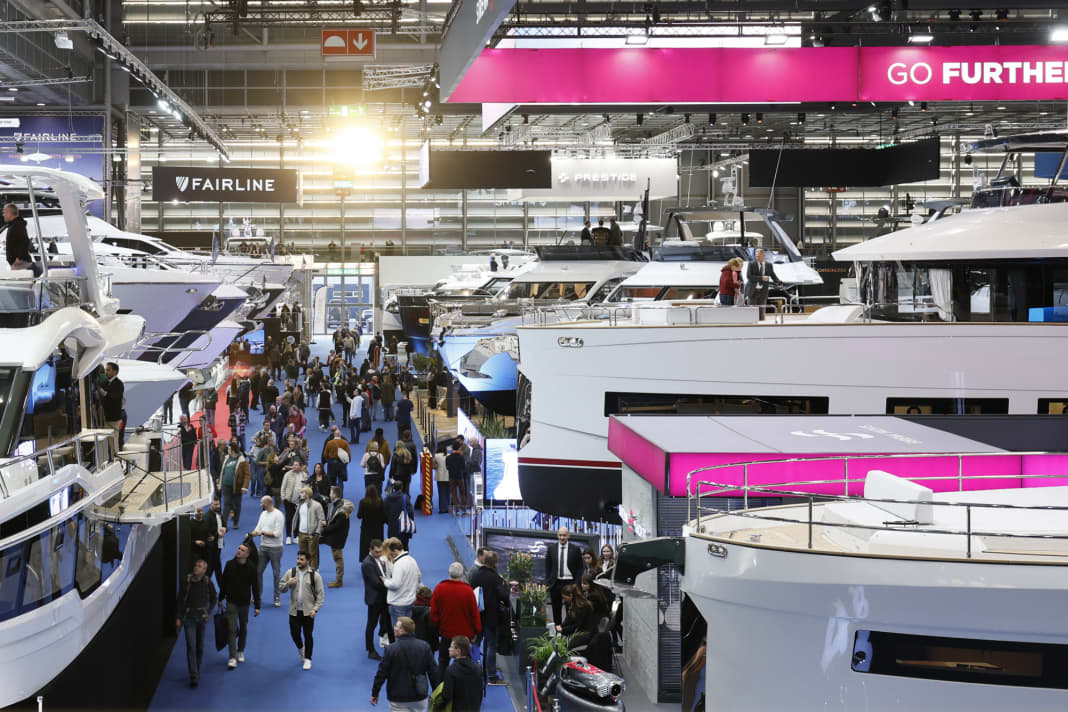





Once a year, the Stockum district of Düsseldorf becomes a Mecca for all those who are famous on the water or simply enjoy travelling on it. For decades, boot Düsseldorf has been a family get-together, the most important networking event and a valuable sales platform with direct customer contact for many manufacturers. Despite the wintry weather on the first weekend and the start of the rail strike halfway through the fair, around 214,000 visitors from 120 countries travelled to the 55th boot. Although the number of visitors was down on the previous year (237,000), the organisers, exhibitors and visitors were satisfied overall.
The first weekend alone attracted almost 55,000 visitors to the trade fair. Among them were many industry experts, for whom the first water sports event of the year is the most important platform for dialogue as well as a source of inspiration and ideas. Many customers and prospective buyers also visited the stands of around 1500 exhibitors from 67 nations to find out about innovations and new products from the industry. Quite a few of them made their decisions on the spot. Boot Düsseldorf boss Petros Michelidakis reported a high level of buying interest among visitors:
Many boats were sold directly from the stand here at the trade fair. And the diving tower and action pool made it possible to test the latest accessories and boards directly on site."
The hands-on activities in diving, sailing, surfing and paddling were once again among the biggest crowd-pullers at the trade fair and attracted young people in particular. The clientele in the 16 halls could hardly have been more colourful and reflected the full range and diversity of water sports. From long-haired surfers and Greenpeace activists to superyacht buyers and high-end powerboat manufacturers, the 220,000 square metres are home to everything that shares a common denominator: A passion for water sports. Robert Marx, exhibitor spokesman and President of Boot Düsseldorf, summarised this unique mix: "boot has once again succeeded in attracting the right visitors to Düsseldorf. They have purchasing power, expertise and a high level of interest."
Many visitors were drawn to the numerous stage programmes with the stars of the scene or to the top-class workshops, some of which were on the programme for both recreational athletes and experts. The Classic Forum, for example, offered short courses for the youngest visitors to try out for themselves. They could build their first sailing boat in the children's boatyard. Numerous boats from different eras were presented here and the development of boat building through the ages was shown. The highlight was the Victoria, a replica of a Roman river galley from the LWL-Römermuseum Haltern am See in Hall 14. In general, however, the focus was on the future wherever you looked.
Trends and highlights
For decades, the trade fair has been regarded as the trendsetter in the industry. The trend towards sustainability concepts in all areas was striking again this year as visitors wandered through the halls. Marine conservation and innovative, sustainable technologies are playing an increasingly important role in water sports and the trade fair has developed into a central dialogue platform for political and tourism decision-makers. The Blue Innovation Dock sustainability forum has become a real driver of innovation. New ideas and visions for more sustainability in boat building, the development of new propulsion systems and the management of marinas and tourism were exchanged here.
Another trend that could be observed at Superboats in hall five was the growing range of luxury toys. The latest "toys" such as motorised foil and jetboards and the latest generation of diving scooters were presented here. Here too, the trend of combining fun and luxury with sustainability continued. Foils, which float almost silently over the water, can also be seen more frequently outside of trend sports. A number of hydrofoil boats were also presented at the trade fair, such as the Electric Hydrofoils from Proteus Boats or the Edorado 8S, which is around eight metres long and can reach speeds of almost 40 knots and was nominated for European Powerboat of the Year in the Electric Boat category this year. The retractable hydrofoils of the dayboat enable variable draught, a feature that was demonstrated on site on dry land.
Another current trend was served by the Omikron OT-60 - a motor yacht - in Sailing Hall 15: boats for newcomers. It is no coincidence that the hull shape and deck layout of the 18.4 metre novelty are reminiscent of a modern, sporty cruising yacht. According to the manufacturer, the OT-60 is the perfect symbiosis of both areas and combines the comfort of a motor yacht with the active lifestyle of sailing - just without a mast. A concept that helped it win one of the coveted Powerboat Awards.
Global players, premieres and award winners
Big, bigger, biggest: Of course, the global players in this market segment were also represented again. Hall six resembled a very exclusive dry marina with the current line-ups from the Ferretti Group, Sunseeker, Princess and other well-known shipyards. The eye-catcher was this year's record holder, the 29 metre long X95: The flybridge yacht weighing more than 100 tonnes covered the last kilometre of its journey (from the crane site on the Rhine to the Princess exhibition area) on a 12-axle special low-loader shortly before the start of the trade fair.
Many other manufacturers used the large stage to present their latest models. For example, the Italian shipyard Wally presented its Wallypower 50, which combines the more open design of the Wallytender with the generous surfaces of the Wallypower 58. Axopar celebrated its 10th anniversary with the market launch of the new 29er series. In 2014, the Axopar 28 was the first Nordic 28-foot boat series with an outboard motor. Other world premieres were presented by the British luxury motor yacht manufacturer Fairline with its Targa 40 and the Finnish shipyard Saxdor Yachts with its new flagship Saxdor 400 GTC.

